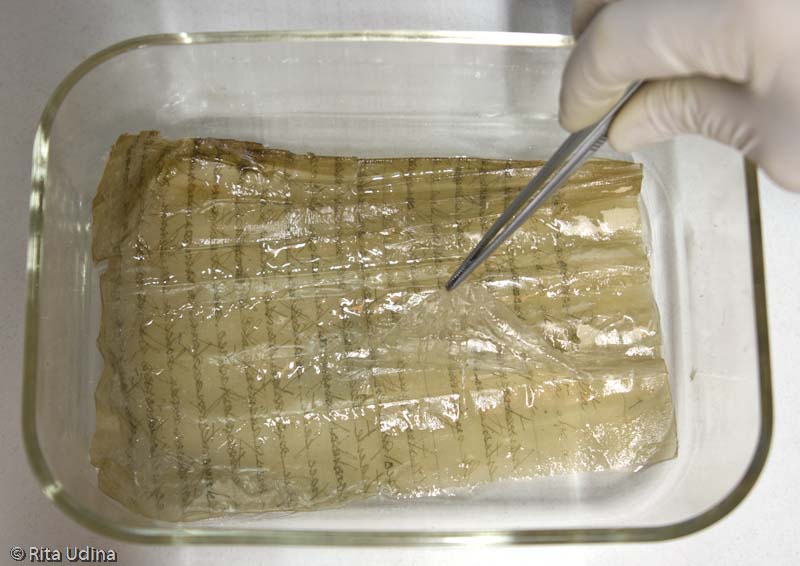lectures
You might want ot see the full list of Published Papers and Lectures.
Find below the portfolio projects related to lectures:
Lecture: ‘Classification of dyes and colorstuff’ at the IPCE
A wide variety of products providing colour to leather and paper are often imprecisely categorized. A correct classification contributes to a better understanding of the their features and is therefore useful both in the recognition in the materials eligible for conservation, as well as in the application of dyes and colourstuff for a proper in-paint and retouch. The dyes and colorants will be discussed according to the most common classifications: pigment based or not, natural/synthetic and, above all, their substantivity: direct, ionic, reactive and complex.
Lecture: ‘Diving in wet treatments’ 2nd edition (IPCE).
First edition of the confernces cicle Re-Enpapelamos was held solely in-person. This year it is repeated free and on-line. ¿Which are the main benefits of bathing? ¿Do wet treatments justify the potential drawbacks involved in them? Let’s see it in five diverse artefacts, washed from least to major degree: a pencil drawing, a gouache, two hand-coloured technical drawings on tracing paper and one pastel drawing.
Lecture: Sewing, adhesion and grain direction in book conservation
Event: AIC 50th Annual Meeting, [...]
Lecture: ‘Conservation of recycled bindings and fragmentology’ (Parts 1 & 2), SICP Chile
Book conservation involves a tough decision making regarding usability and long term preservation handling. Sometimes we are dealing with fragmentology, or disjecta membra (fragments of written supports are re-used as part of a binding, with a diverse purpose from the first use) whereas in other cases the purpose is the same, and the whole binding is being recycled to bind a different book. Incunabula and manuscripts with laced-case and limp vellum bindings are studied.
Lecture: ‘Conservation of reused bindings’ (Part two), Dubrovnik
Book conservation involves a tough decision making regarding usability and long term preservation handling. Sometimes we are dealing with fragmentology, or disjecta membra (fragments of written supports are re-used as part of a binding, with a diverse purpose from the first use) whereas in other cases the purpose is the same, and the whole binding is being recycled to bind a different book. Incunabula and manuscripts with laced-case and limp vellum bindings are studied.
Lecture: ‘Conservation of re-used bindings’ (part one), Zagreb
Book conservation involves a tough decision making regarding usability and long term preservation handling. Sometimes we are dealing with fragmentology, or disjecta membra (fragments of written supports are re-used as part of a binding, with a diverse purpose from the first use) whereas in other cases the purpose is the same, and the whole binding is being recycled to bind a different book. Incunabula and manuscripts with laced-case and limp vellum bindings with rolled sewing on parchment are studied.
Lecture: ‘Sew it, rather than paste it!’
(ERC Conference, Krems)
Event: Conference Book Conservation: One [...]
Lecture: ‘Reversibility
in book and paper conservation’ (INTACH, Dehli)
Event: INTACH lectures (#52). Organization: [...]
Lecture: ‘Impregnated Tracing Paper Conservation’ (ICON Book & Paper)
Three study cases of conservation of impregnated tracing paper, with diverse approach
Lecture: “Conservation of Impregnated Tracing Paper” (Papers at the balcony, Granada)
Three study cases of conservation treatment of impregnated tracing paper with three diverse approaches.
Workshop: Introduction to paper conservation (Sentmenat, 2020)
Introductory workshop to paper conservation (International Archives Day).
Lecture: “A possible solution for paperback bindings” (ICPWH, Sarajevo)
Event: First International Conference on [...]
Workshop: Introduction to paper conservation (International Archives Day)
Introductory workshop to paper conservation (International Archives Day).
Lecture ‘Diving in wet treatments’, first in-person edition (IPCE)
¿Which are the main benefits of bathing? ¿Do wet treatments justify the potential drawbacks involved in them? Let's see it in four diverese artefacts, washed from least to major degree: a pencil drawing, a gouache and two hand-coloured manuscripts.
Lecture: 20th anniversary of the conservation laboratory CRAI-UB
Event: 20th anniversary of the conservation [...]
Lecture: “Reversible vs Irreversible” (Cores Symposium, Brugge)
Event: Cores Symposium. Dilemmas: Between cherishing [...]
RECH 4 – Retouch in Cultural Heritage
Event: RECH 4 - REtouch in [...]
Lecture: “Removal of PET plastic film from a laminated manuscript” (SERCA, Atlanta)
Owner: Private collection Object: Laminated [...]
Lecture: Silver mirroring in photographs conservation (Fotoconnexió)
[translation pending] Data: 1 de desembre de 2014. [...]
Lecture: “Replacement of oils on impregnated paper architectural drawings” (Amsterdam)
Date: 7th october 2014. Place: Nationaal [...]
Clients
Filter project by:
ARTEFACT
artwork on paper
drawings
maps, plans (architectural drawings)
posters
board or paper artefacts
books
albums
bindings conservation
codexs
fragmentology (membra disjecta)
recycled binding
incunabula
limp parchment binding
paperback books
sewn unsupported with drawn-on covers
stationery bindings
documents
holdings (archive/library)
oversized
photographs
albumens
daguerreotypes
silver-gelatin
glass-plates
silver-gelatine paper photographs
COURSES
book conservation
housing, mounting and framing paper artworks
introduction to paper conservation
Matching infills & retouching
photograph conservation
tailored conservation course
wet treatments
DISSEMINATION/RESEARCH
MATERIALS
TECHNIQUE
ball-point pen
charcoal, pastel
cyclostiled
felt-tip pen
gouache
graphite, pencil
ink
manuscripts
prints
engraving
lithograph
watercolor
woodcut
TREATMENT



















